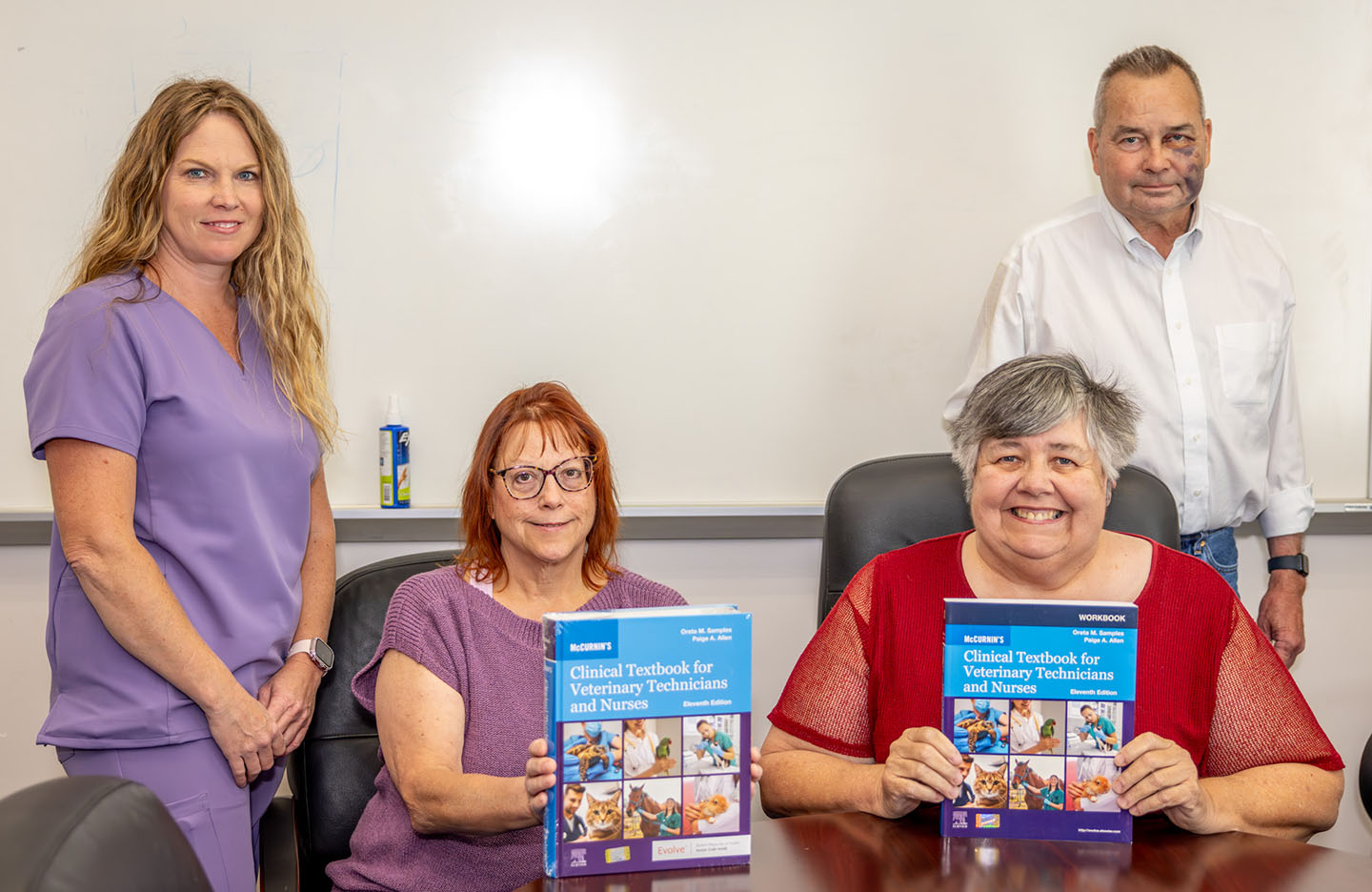Newsroom
Widely used textbook features writings from Fort Valley State staff
Posted on May 16, 2025

(From left to right) Leiah Brooks, Karen Capps-McMullen, Dr. Oreta Samples and Dr. George McCommon all wrote material for a veterinary technology textbook.
A quartet of Fort Valley State University (FVSU) faculty and staff recently contributed information to a veterinary technology textbook and its accompanying workbook.
Dr. Oreta Samples, program coordinator for FVSU’s Master of Public Health program, is the chief editor of the 11th edition of McCurnin’s Clinical Textbook for Veterinary Technicians and Nurses.
Dr. George McCommon, tenured professor in veterinary sciences, along with veterinary technologists Leiah Brooks and Karen Capps-McMullen, provided additional material for the publication by authoring chapters on a variety of veterinary medical topics related to veterinary technicians.
The purpose of the textbook is to provide information used in the training and education of veterinary technology students.
“This book is the most widely used veterinary technician textbook there is. It’s used in the U.S., Europe and Australia predominately for training in two- and four-year programs for veterinary technicians,” Samples said.
Furthermore, the FVSU professor said this is the third edition that she’s worked on. For the previous two editions, she was one of two co-editors.
“When the chief editor retired after the 10th edition, I was offered the role of chief editor,” Samples said.
Paige Allen, a former veterinary technician educator at Purdue University, served as co-editor with Samples for the textbook. Based on their experience with the 11th edition, they both plan to stay on for many years of revisions.
Additionally, FVSU staffers also wrote or co-wrote chapters in the book. McCommon penned four chapters and said it was an honor to be involved in the project.
“This was my first time being involved in book publishing. I am both grateful and honored that Dr. Samples thought enough of me to ask me to join in this opportunity,” Brooks said.
In co-writing a chapter with fellow veterinary technician Capps-McMullen that focused on clinical microbiology, Brooks was excited about contributing to her profession.
“As a licensed veterinary technician, it is a privilege to be part of something that will further the education of future generations of veterinary technicians,” Brooks said.
Samples, who usually writes seven or eight chapters, only contributed two to the current edition of the textbook, but it wasn’t for lack of material.
“I was advised to drop it down to two chapters, since I was serving as editor,” Samples said. The editor is required to proofread every chapter of the book before it can be submitted for publication. The current text has 38 chapters and encompasses 1,312 pages.
When it comes to the book being an effective tool for students, Samples gives a two-pronged perspective.
“We hope that they will be able to take away the proper methods needed to practice veterinary technology in terms of the different procedures and medical assistance needed when doctors are working on patients. The second is because the book is so comprehensive and covers every facet of veterinary technology, we hope that it makes it more economical when students must buy textbooks,” she said.
To describe the book’s thoroughness, Samples said the book covers as many as 15 genres of topics in the veterinary technology field. This cuts down the number of books needed to cover the same amount of material.
For FVSU’s veterinary technology students, Samples said the textbook is a must have.
“It is required for all their veterinary technology courses. We ask them to purchase the book during their freshman year and not sell it because it will be needed all four years,” she said.
The FVSU instructor added that the book’s publisher, Elsevier, said that it’s their top selling veterinary technology textbook.
Additionally, Samples went on to describe what fuels her passion for textbook writing.
“My main driving force that inspires me is that I love to write in the veterinary technology genre.”
She said she got started by writing several articles for veterinary technology journals such as the Association of Veterinary Technician Educators and the National Association of Veterinary Technicians and Assistants.
In Samples’ opinion, one must push their ego to the side to be an effective textbook author or editor. It involves a lot of writing, and she added that it’s a learning process that will see one receive a lot of rejection letters before getting articles accepted, but the results will eventually be positive. The key is learning what the publication is looking for.
“One day, if you enjoy writing, you’ll get to the point where you say, ‘This is not hard. It’s a lot of work, but it’s not hard.'”
Dr. Keith Howard, dean of FVSU’s College of Agriculture, Family Sciences and Technology (CAFST), complimented Samples and her colleagues on their contributions to the textbook.
“This achievement is especially noteworthy as Dr. Samples served as editor for this monumental project. This textbook is and will remain, a foundational resource for veterinary technician education both nationally and internationally,” Howard said. “Congratulations to this exceptional team for their dedication, scholarship and lasting impact on veterinary technology education,” he said.
The book is available directly from Elsevier Publishing and Amazon. Hard copy editions are also available at the FVSU Bookstore.
For more information about FVSU's Veterinary Technology and Master of Public Health programs, call (478) 825-6424/6353 or visit https://bit.ly/4jsAWhP.
- Categories:
- FVSU Agriculture College